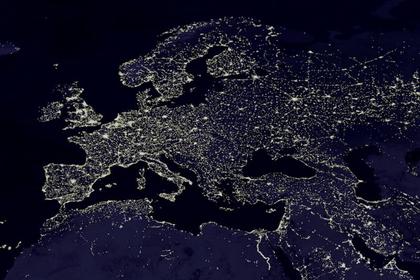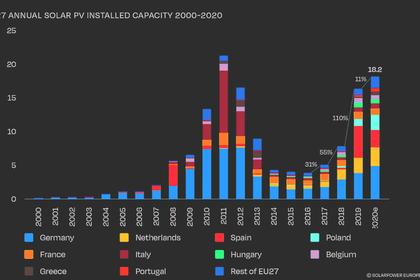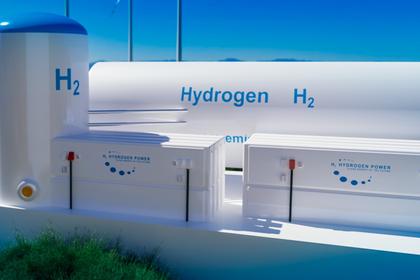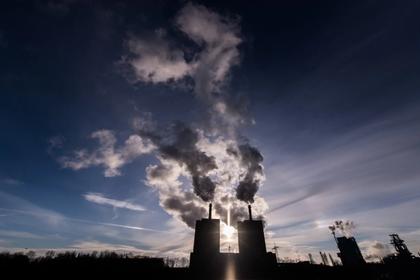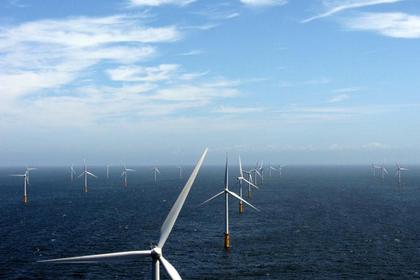
EUROPEAN RENEWABLES HAVE TO DOUBLE
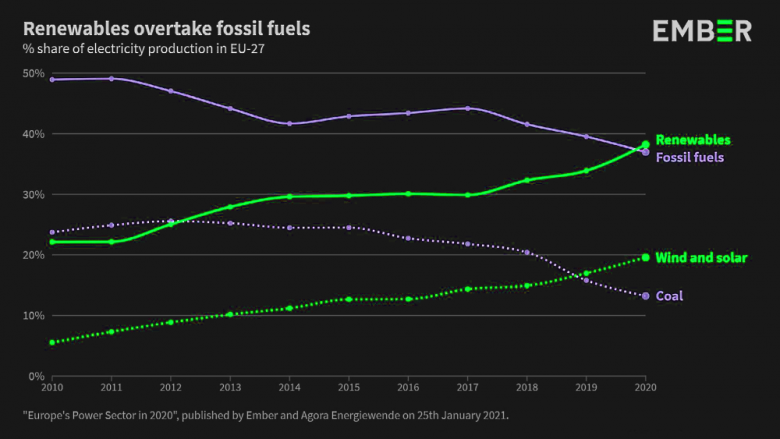
GTM - JANUARY 26, 2021 - European Union countries generated more electricity from renewables than from coal and gas for the first time ever in 2020, according to a report released Monday.
But despite the progress, much work is left to do if lofty new climate targets are to be met.
Coal power slumped by 20 percent year-on-year while solar and wind power grew 15 percent and 9 percent, respectively. Coal generation among the EU-27 nations has halved since 2015, according to the study conducted by think tanks Agora Energiewende and Ember.
While renewables' 2020 performance was impressive, especially during a global pandemic, the report warns that the average pace of deployment through the 2020s will need to more than double that of the prior decade if the EU is going to hit its target of a 55 percent reduction in emissions by 2030.
The majority of the new renewables capacity came from wind and solar. An extra 55 terawatt-hours were generated from these two sources in 2020, but the average tally for new additions this decade will have to be closer to 100 terawatt-hours per year to meet the 2030 target. The average through the last decade amounted to an extra 38 terawatt-hours.
"In order to achieve the 100 terawatt-hours of annual expansion required for climate-neutrality, however, the level [of] 2020 needs to be doubled," said Patrick Graichen, director of Agora Energiewende, in a statement.
"The economic recovery after the pandemic must not slow down climate protection. We...need a strong climate policy — such as the Green Deal — in order to guarantee steady progress," he added.
Doubling new generation may not be impossible
When you break it down, the prospect of adding twice as much fresh energy per year is not quite as hard as it looks. For starters, forecasts by the two trade associations serving the wind and solar industries show possible increases of that magnitude in new capacity.
If the EU-27 plus the U.K. deliver on their National Energy and Climate Plans for 2030, WindEurope expects the installed capacity of 2020 to double by 2030. That figure includes offshore wind capacity exceeding the combined EU-27 + U.K. target of 100 gigawatts. Detailed efforts to invest in grid infrastructure in the Green Recovery program will go some way to shifting ambitions if they can be realized.
The solar outlook is much better. SolarPower Europe tracked 18.2 GW of deployment in 2020. As early as 2024, this figure will be 35.1 GW, just shy of a doubling before the midpoint of the decade.
The Agora/Ember report shows how much potential remains when the electricity mix of EU nations is compared. Major economies, including France, Italy, Netherlands and Poland, all get less than 20 percent of their electricity from wind and solar. France is stuck at around 10 percent. By 2035 it will reduce its reliance on nuclear power from 75 percent to 50 percent. The first reactors started shutting down last year.
Newly installed gigawatts offer more bang for the buck
Importantly, 1 gigawatt of wind and solar added in the 2020s is going to deliver more energy than 1 GW added in the 2010s.
Higher-efficiency solar modules and higher capacity factors for wind will take advantage of technology improvements. Bifacial solar paired with trackers moves the needle again. Better operational practices, smarter grids and energy storage pairings will mean less downtime and less curtailed power.
Developers will hope that streamlined permitting and lower-pressure on-grid connections will also remove some of the costs from that stage of the process.
The cost of capital for renewables is also headed in one direction. Research from the International Renewable Energy Agency shows that $1 million invested in solar in 2010 delivered 213 kilowatts. In 2019, that same $1 million could buy just over 1 megawatt.
Those capital cost reductions mean that increased investment will deliver multiples on investment over the past decade. Greater investment from the oil majors could surpass $30 billion annually according to a pre-pandemic study by CMS and Capital Economics. That’s a 10 percent boost for renewables, which attracted just over $300 billion of investment in 2020, according to BloombergNEF.
-----
Earlier:
